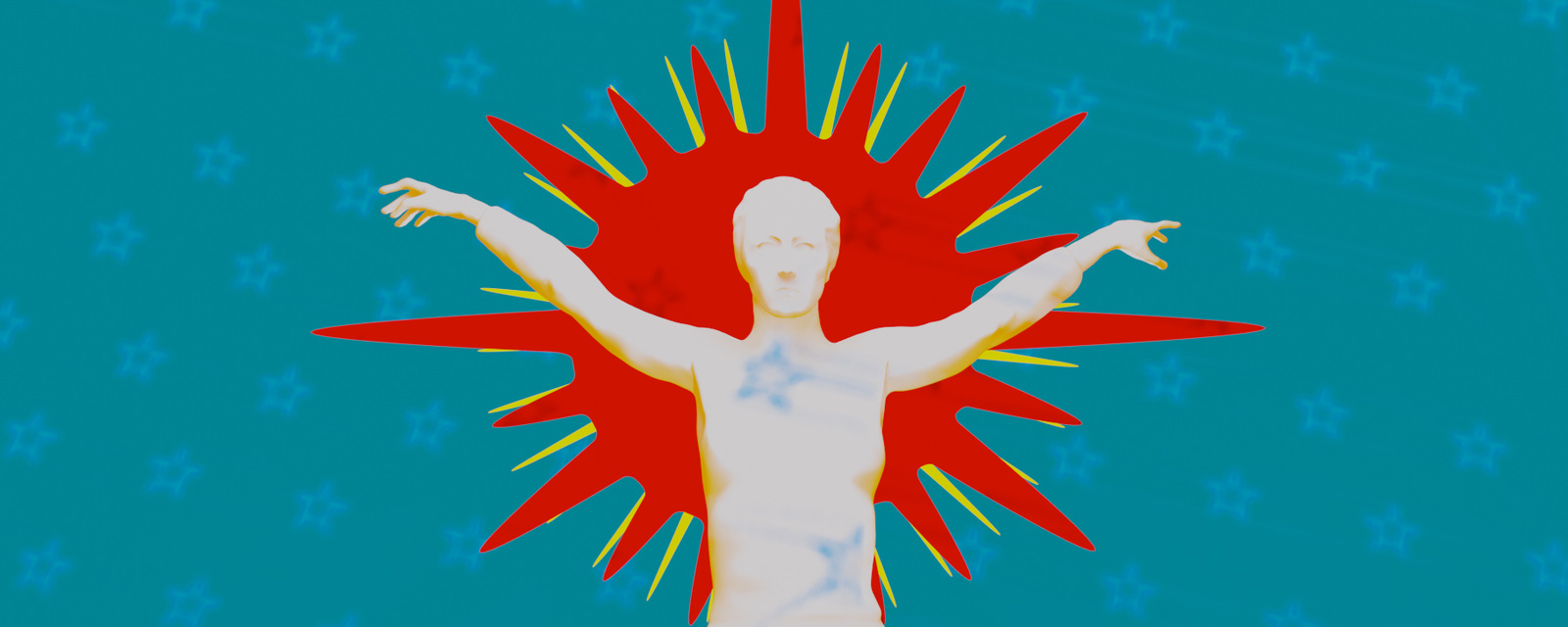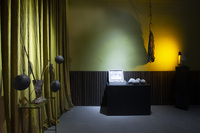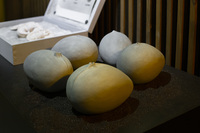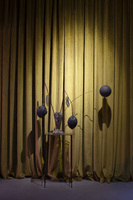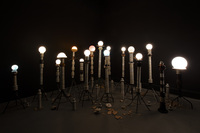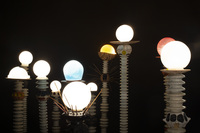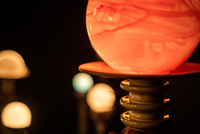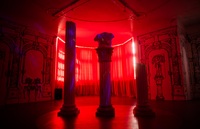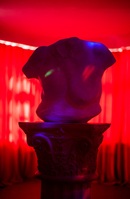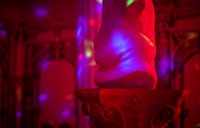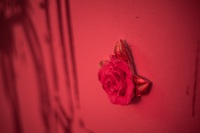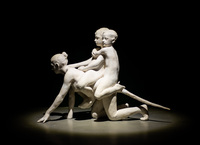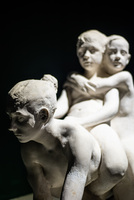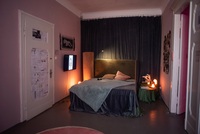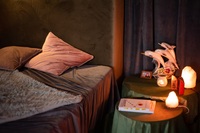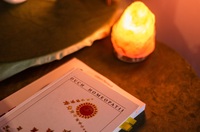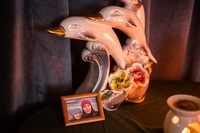The womanhouse is an area of small deeds. It is the opposite of great men's acts. Brotherhood is in fighting, sisterhood is in care.
To quote Jolanta Brach-Czaina: "the basis of our existence is everyday life". The house is an area where we bustle about. We are ashamed of this everyday life, although it is the sense of our existence. This is why, we should do everything to strip it off of the shame and banality and bring it to light. The symbolic house is where women give tribute to society – tribute in the form of care and cleaning. The professions of nurse and cleaner are still commonly used only in the feminine form. It is not without a reason that they are also badly paid. Society is unable to respect the care and cleaning activities because this work was and is done for free, as a woman's duty, part of her role in life. Women do an average of 4.5 hours of housework per day, free of charge. They also perform 80 percent of all domestic duties.
While working on the series of exhibitions titled The Womanhouse at the Kronika CCA, we will reflect on where the domestic women's movement stands more than 100 years after Polish women gained the right to vote. For the exhibition "I had to become the sun myself" we invited three artists and a group of women from the Amazons’ association. Their works allow us to come to know the experience of individual women, the experience that matters the most at the moment, being at the same time an attempt to find one’s way in the time of chaos and ubiquitous danger.
In the waiting room to a better tomorrow, the bedroom, the room made of light and the ballroom, we feel the energy the women send to each other and to themselves. Their care is directed not outwards, as in the stereotypical role, but inwards, through forms of self-healing, building a protective zone, and finally through spontaneous communal dancing. As the poet Anna Świrszczyńska said: "When the sun went out over me, I had to become the sun myself. It was difficult, but now – what comfort!"
Małgorzata Goliszewska (born in 1985) – multimedia artist, director. Graduate of the Academy of Art in Szczecin. She works with various media (film, video, objects, installations, photography, performance, text, sound, drawing). She is interested in exploring and expanding the boundaries of documentary filmmaking and working directly with others. She is a scholarship holder of the Vordemberge-Gildewart Foundation (2017), the Młoda Polska Festival (2015), Socrates Erasmus at the University of Art and Design in Cluj-Napoca, Romania (2014) the winner of the Minister of Culture and National Heritage Award (2014, 2013) and the 13th edition of the Hestia Artistic Trip competition.
Dorota Hadrian (born 1984) – visual artist. In 2004-2010, she studied at the Faculty of Sculpture and Graphics at the Academy of Fine Arts in Krakow, and obtained her doctoral degree at the Faculty of Art of the Pedagogical University in Krakow. In 2008, she was awarded the Jan Matejko Fellowship, and in 2010 and 2014, she received the scholarship from the Ministry of Culture and National Heritage. In her artistic practice she makes use of iconographic patterns developed in classical European art and uses cultural, multifaceted references, allusions and quotations. The main theme of her artistic explorations is the struggle against stereotypes in culture and popcultre. Her main means of expression are sculpture, video and painting. She lives and works in Bytom. The winner of the President of Bytom MUZY 2019 Award for creative achievements.
Patrycja Orzechowska – a multimedia artist, author of art books; her artistic activities involve photography, collage, ceramics, installation, collecting, applied graphics and ready-mades. She graduated from the graphic design at the Academy of Fine Arts in Gdańsk and the Interdisciplinary Doctoral Studies at the University of Arts in Poznan. She held multiple scholarships of the Ministry of Culture and National Heritage, the Marshal of Pomorskie Voivodeship and the Mayor of Gdańsk. Her works have been presented at numerous solo and group exhibitions and are held in private and public collections. She lives and works in Gdańsk.
www.patrycjaorzechowska.com
____________________
Womanhouse is a new series in the Kronika CCA, presenting the current situation of women in Poland through their personal stories, microherstories.
The exhibition project is a visual essay by today’s generation of female multimedia artists, based on the experience of their predecessors: those who began the process of equalising women's rights at the beginning of the 20th century, while also having a significant impact on regaining independence, and the activists of the 1960s and 1970s. The female artists invited to the project focus on the same social problems that still require a visionary approach, revising the postulates made in recent decades according to the principle: you have to look back to understand what there is still to do, and to do it well.
The title "Womanhouse" refers to two historical cultural works. The first is a psychological drama by Zofia Nałkowska. Its theatrical premiere in March 1930 was a breakthrough moment for Polish women playwrights, marking a break with the male monopoly on theatrical creation.
In Nałkowska's work, the house represents the world of women who are lonely, unhappy, living in the past, helpless without men. It is a dramatic history of women who feel unnecessary, having no influence on their own lives. At the Kronika CCA we reverse this situation, giving the symbolic Womanhouse the power to make things happen.
The second of these contexts is the landmark exhibition “Womanhouse” (1972), a landmark in the history of contemporary art, which we recall on its fiftieth anniversary. This was the first public feminist art installation and performative space, organised by Judy Chicago and Miriam Schapiro, co-founders of the California Institute of the Arts Feminist Art Program. Their intention was to transform the home environment into one that fully expressed women's experiences. In an abandoned Victorian house in Hollywood, an exhibition was held that brought feminism into the popular consciousness, which in the early 1970s was a revolutionary act and caused a lot of discussion. In the 1972 project, the artists presented 'bourgeois' women's roles and by arranging individual rooms as art installations and explored the current social consciousness.
The exhibitions at the Kronika CCA will loosely refer to this exhibition. The gallery space, originally a flat in a tenement house of the Jewish Cohn family, will be arranged by the artists and participants of the project using site-specific forms.
The visual artists we have invited expand their artistic practice to include a wide range of interdisciplinary activities. Their work is the result of analysis of social structures, consultations and workshop activities. Although the authors have different backgrounds and experiences, they conduct their artistic practice based on the pursuit of social change. They address the inequality of women in many areas: economic, educational, national minorities, ethnicity, sexuality. Some of the works will be created during workshops with Bytom women's groups.
- Exhibition
- 19 November ‒ 30 December 2022
- artist: Małgorzata Goliszewska, Dorota Hadrian, Patrycja Orzechowska
- curator: Agata Cukierska, Katarzyna Kalina
- exhibition opening: 18.06. (Saturday), 7:00 PM–9:00 PM
- Part of the Dom Kobiet/Womanhouse cycle
- temporarily closed: 22.10 (Saturday) - 18.11 (Friday)
- re-opening: 19.11 (Saturday), 5:00 PM-7.00 PM
- visual identity: Marcin Wysocki
- photo documentation: Julia Pałkowska, Marcin Wysocki
